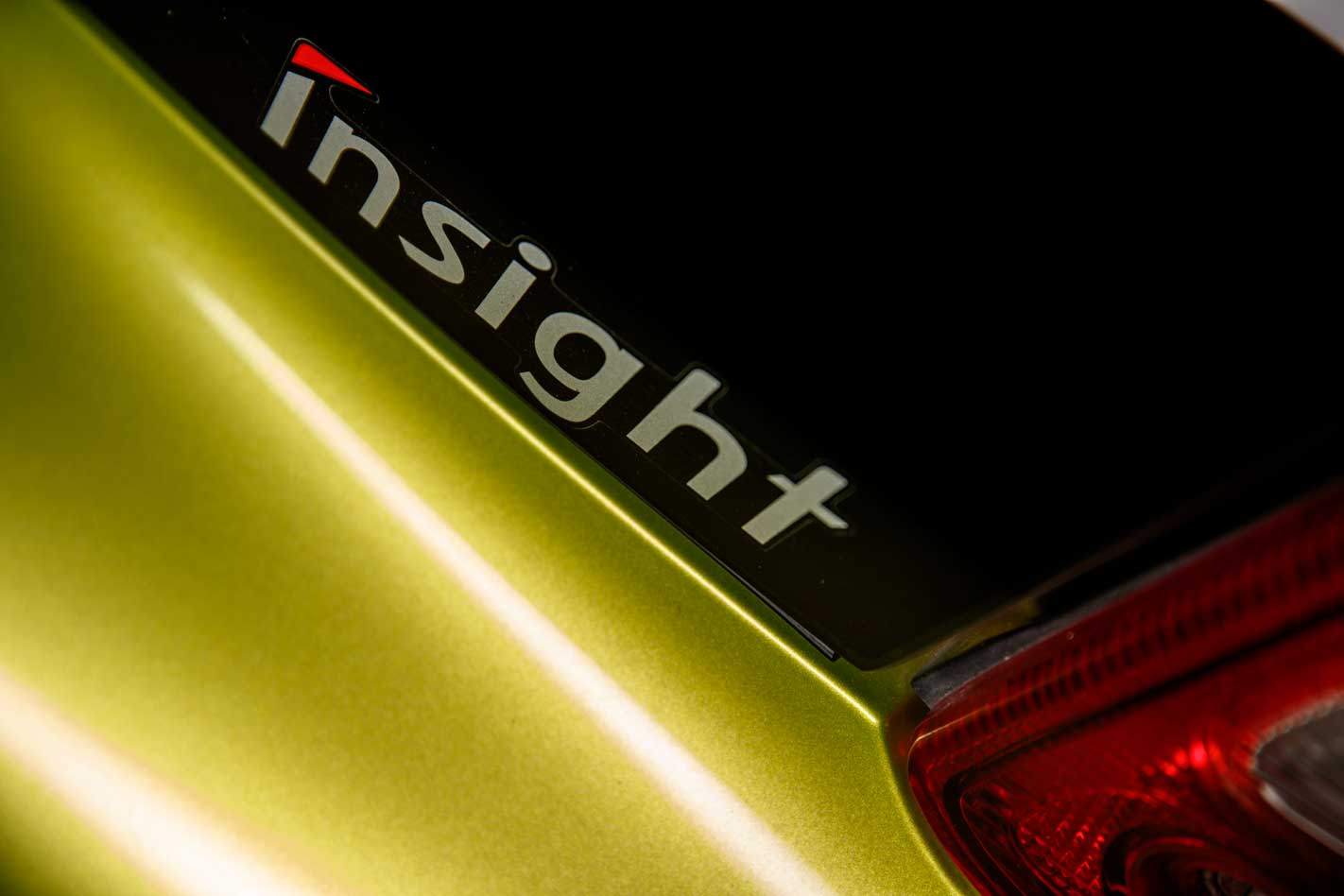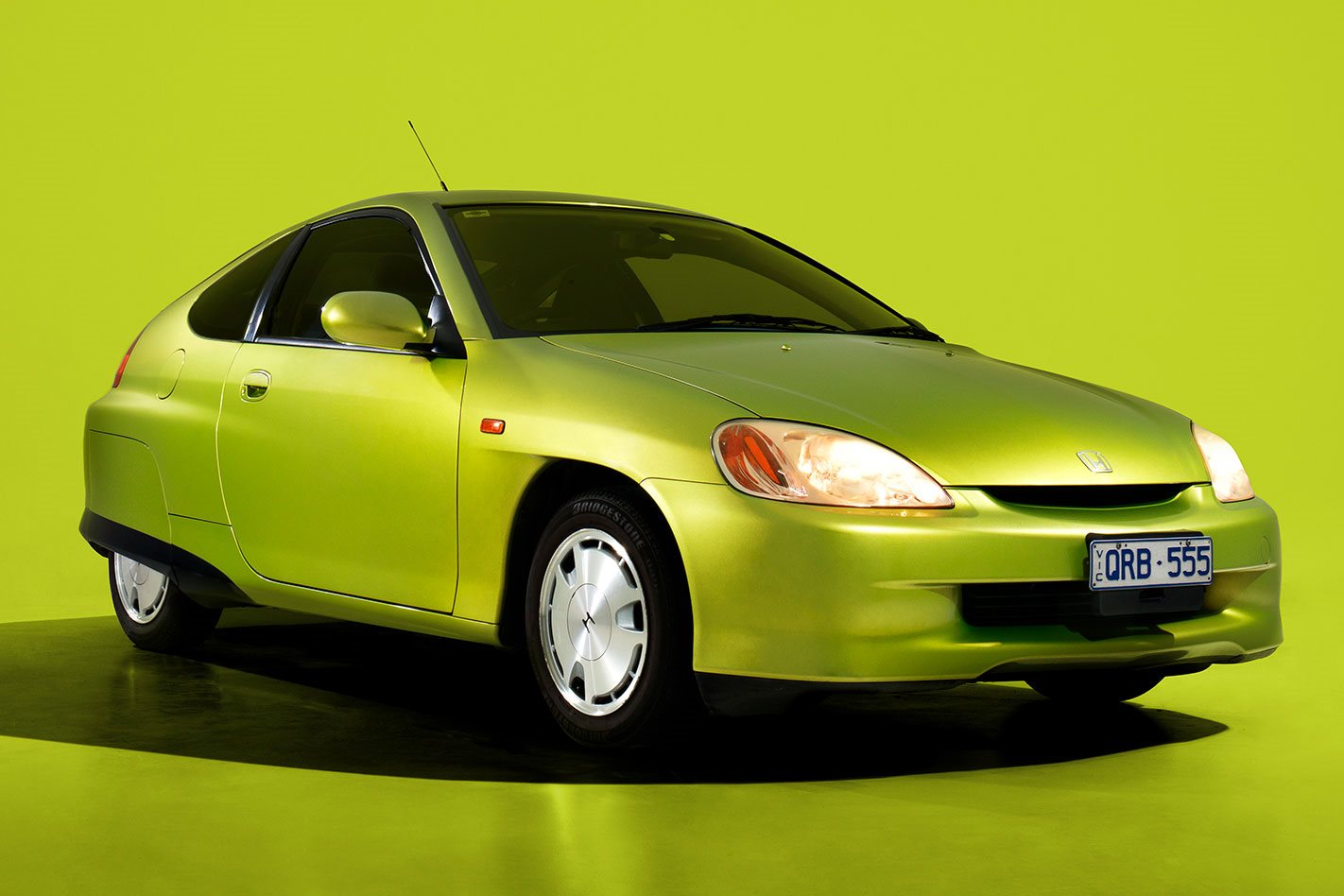The Honda Insight G1 was never built to last. As much as we’ve become latterly accustomed to the idea of a five-year warranty or the notion of Honda’s obsessive engineering, there’s an inevitable mortality to the Insight. By modern standards it enjoyed a cranefly-like existence, the terminal failure of its hybrid battery packs being something you could guarantee. The Integrated Motor Assist (IMA) system could flatline with as few as 25,000km on the clock. Yet an issue that would sound the death knell for any other vehicle as a collectible classic is exactly what has sparked the Insight’s cult appeal. It’s probably the first modern classic you can home hack.
Just as there is a whole generation who know exactly which coin was best for adjusting the mix on a Stromberg carb, so there’s now a burgeoning community that has formed a knowledge base entirely outside the manufacturer’s aegis. The Insight’s position in automotive history was already cemented as one of the very first modern petrol-electric hybrids. What happened after that is in many ways even more fascinating.
The Insight was a commercial flop. When Honda first unveiled the car, it claimed that it would limit production to 6500 units per year. It struggled to sell half that number. The total production run from 1999 to 2006 ran to just 17,020 units, hampered by a complex build process, a limited market for two-seat city cars and, from 2003, competition from the hugely successful XW20 Toyota Prius. The Prius’s green credentials were burnished by the fact that it could run purely on electric power for short periods, whereas the Honda’s IMA system acted purely as a booster for the always-on petrol engine. This technical distinction was key in terms of green perception.
Honda’s Takanezawa plant in Tochigi was the home of the NSX. The company’s brightest and best worked on its halo car’s labour-intensive aluminium fabrication. The greater Tochigi campus was a self-contained R&D lab within the business. Design studios, rapid prototyping facilities and testing on the nearby Twin Ring Motegi circuit could fast-track ideas into existence. Another aluminium sports car, the S2000, was launched in 1999 out of Tochigi, with the Insight joining it. Tochigi represented Honda’s millennial shop window. It didn’t last.
Having opened in 1990, the Tochigi plant was shuttered in 2003, with Insight production moving to another facility with a handy strip of test tarmac: Suzuka. The so-called ‘small-volume models’ ran on a new line with a self-fulfilling capacity of just 60 vehicles a day. It was Honda’s tacit admission that, after four years of dwindling sales, the Insight hadn’t succeeded. Production halted in May 2006 and the nameplate wouldn’t appear on a new Honda for another three years.
The facts would appear to indicate that Honda built an expensive and impractical car with a suboptimal hybrid system that consequently sparked little in the way of demand. Yet these ingredients are almost the perfect crucible for a future cult classic. The Insight is quirky, relatively rare, strangely exotic and has become more desirable with every passing year. I once visited the offices of a performance car magazine in the UK and was stunned by the quantity of privately owned Insight G1s.
Wheels’ test of the $48,900 Insight in April 2001 saw John Carey fill the 40-litre tank and set aside 24 hours during which he expected to cover over 1000km of city and suburban driving. The first car with idle-stop he’d ever driven, the Insight also required Carey to recalibrate his driving, welcoming the opportunity to brake to recharge batteries, something that’s anathema to good fuel economy in a conventional combustion-engined vehicle.
“At the 24 hour mark, the fuel tank is showing empty and the trip meter displays 935km,” he wrote. “I’m tired but I must know if the Insight can achieve 1000km of city driving on a 40 litre tank. It takes almost an hour, but the Honda makes it. A few minutes later, at 1003km, after a couple of apologetic coughs, the Insight finally expires. It’s over.”
As impressive a technical achievement as this was, Carey was equivocal about the chances of a car that Honda had admitted would be challenged to shift 60 units in the remainder of 2001. “For hybrid technology, it’s a point emphatically proved. But this doesn’t mean the Insight is a brilliant car. Its focus on the achievement of low fuel consumption compromises practicality at the same time as pushing the price into the stratosphere.”
Carey had speared the Insight’s weaknesses and then set out the template for its replacement. “When Honda shows us the $30,000 five-seat hatchback that’s capable of, say, 5.0L/100km around town, then they will have a significant car as well as a significant technology.”
The hybrid tech was indeed significant and, by today’s standards, minimal. The electric motor fits into a tiny 60mm niche between the engine and the transmission casing. Where a Prius featured a bulky generator to divert engine power to the batteries, the Insight does without, regenerative braking or coasting turning the 10kW brushless motor to a battery generator. The battery pack is compact too, weighing just 20kg, the 144-volt nickel-metal hydride cells located beneath the rear hatch.
It’s hard to argue with the results, though. Even when it was withdrawn from sale in 2006, the Insight was still the most efficient vehicle on sale in the USA, thanks in no small part to a slippery drag coefficient of just 0.25. Honda quoted an overall figure of 3.4L/100km on the highway and 3.9L/100km in town for the export CVT version. A total system output of 56kW at 5700rpm meant that the Insight was never particularly quick, but it could weigh as little as 827kg in production trim. Everything was featherlight. Even the spare wheel was made of aluminium.

Honda’s prediction that the battery pack should last around 10 years or 160,000km proved wholly optimistic. The one consolation is that when the IMA system does give up the ghost, your Insight isn’t rendered immobile. The 1.0-litre, three-cylinder petrol engine will still propel the thing, albeit even more slowly than before. It even has a back-up 12V starter motor. Fortunately help is at hand. A lot of help.
Honda originally pitched a replacement battery pack at $4900. That’s quite an outlay when some packs were failing after around three years and the replacements were no better. Fortunately, even what seems to be a dead battery can be revived, with the process for doing so posted online. Analysis of the battery pack takes about nine days and you will become an expert on charge/discharge cycling of the battery sticks, charge balancing of cells and such like. A Super Brain 989 Peak Charger is your friend here.
This shouldn’t need saying as we’re all smart people, but let’s just be crystal clear. Working on an electrical system, even one that doesn’t appear to exhibit the vital signs of high voltage, can be deadly. An IMA isn’t something you can just jab a Bunnings volt meter into. If you’re not comfortable with working with high voltages, leave it to an expert. Above all else, ensure that no standing voltage is present, wear static-free clothes, and plastic tools are a good idea to avoid discharge risks.
With minor modifications, the battery pack can be grid charged, much like a modern EV. We’ve even seen the NiMH batteries being swapped for more modern lithium-ion cells, although this is one for the advanced hobbyist only. Fuel consumption is reduced still further, with highway economy figures of below 2L/100km. If analysing and renovating the existing battery pack seems a job too far and funds aren’t limitless, companies such as Bumblebee Batteries can supply increased-power 8.0 amp-hour NiMH cells. Total cost for the whole stack? Around $3000.
Want to go further? The car’s software is an open book and some owners have fitted a system with an F1-style KERS boost switch, customisable regeneration settings, and the ultimate Insight hack, electric-only running. The list of improvements and workarounds is vast and includes improved underbody aluminium panels, lean-burn optimisation and even cut-down Daewoo Matiz springs fitted to improve handling and load capacity.
‘Fixing’ the Insight has become a delightfully nerdy obsession. It was never a great car but has always been a fascinating one, and its current owners represent a new and supremely enterprising generation. Honda launched this slice of Japanese esoterica into such a rapidly moving market that it was virtually obsolete the moment it appeared. Today it’s a time capsule that embodies all of the excitement, the promise and the technological acceleration of a new millennium. Rather belatedly, it deserves our love.
Who owns one? Andrew from Melbourne
“I love the Insight’s fuel economy, light weight and styling. They’re quirky, different and full of character. I bought a red one in 2005 and then added this car in 2012. It can be grid charged and it has heavier springs front and rear along with adjustable dampers. There’s a dedicated enthusiast community based mainly in the US (Insightcentral.net) where there’s lots to learn about Insights and improvements that can be made to them. From the factory, the handling could have been better, but the modifications made to my cars are a big improvement. Insights don’t have a lot of power but they enthusiastically give all they’ve got. What’s not to love about that?”
The good: Uber-cool ‘Jolly Cabs’ styling; fuel economy still stands up; advanced body; sense of community among owners; investment potential
The bad: Requires a hands-on approach; very slow; rides poorly; two-seater layout is impractical; Aussie examples don’t change hands all that often
Fast facts
So how many Insight G1s did Honda manage to shift in Australia? Well, put it this way: they’re rarer than Lamborghini Aventadors. Just 45 were sold: 20 silver, 16 red, seven green and two black. All were manual but a handful of used imports with CVT transmissions were subsequently shipped in.
Honda Insight in numbers
- 84 – Insight battery packs to one tesla P100D battery pack
- 56kg – weight of the 1.0-litre three-pot engine
- 47 percent – lighter bodythan an EP Civic
- $7910 – more than a DC2 Integra Type R back in 2001
- 22:1 – lean-burn air to fuel ratio
Honda Insight G1 Specs
| Model: | Honda Insight G1 |
| Engine: | 995cc inline-three, sohc, 12v |
| Max power: | 56kW @ 5700rpm |
| Max torque: | 113Nm @ 1500rpm |
| Transmission: | 5-speed manual |
| Weight: | 827kg |
| 0-100km/h | 15.0sec (as tested) |
| Economy: | 4.0L/100km |
| Price: | $48,900 (1999), from $15,000 (now) |






